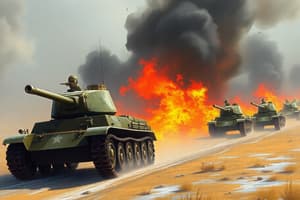Podcast
Questions and Answers
What is a primary characteristic of Blitzkrieg that differentiates it from traditional warfare?
What is a primary characteristic of Blitzkrieg that differentiates it from traditional warfare?
- Reliance on naval support
- Use of only infantry units
- Static defensive positions
- Concentration of force at specific points (correct)
Which phase of the Blitzkrieg strategy primarily involves the use of air power?
Which phase of the Blitzkrieg strategy primarily involves the use of air power?
- Encirclement
- Breakthrough
- Consolidation
- Initial Attack (correct)
What significant change in warfare is attributed to the implementation of Blitzkrieg tactics during World War II?
What significant change in warfare is attributed to the implementation of Blitzkrieg tactics during World War II?
- Return to cavalry charges
- Increase in trench warfare
- Greater emphasis on naval warfare
- Shift towards mobile operations (correct)
How did Blitzkrieg tactics impact enemy morale during military engagements?
How did Blitzkrieg tactics impact enemy morale during military engagements?
Which factor played a crucial role in the effectiveness of Blitzkrieg's mechanized warfare?
Which factor played a crucial role in the effectiveness of Blitzkrieg's mechanized warfare?
What was one of the limitations faced by Blitzkrieg tactics as the war progressed?
What was one of the limitations faced by Blitzkrieg tactics as the war progressed?
In terms of psychological warfare, how did Blitzkrieg tactics affect civilian populations?
In terms of psychological warfare, how did Blitzkrieg tactics affect civilian populations?
What was a key logistical requirement for successful Blitzkrieg operations?
What was a key logistical requirement for successful Blitzkrieg operations?
How did the integration of combined arms enhance the effectiveness of Blitzkrieg?
How did the integration of combined arms enhance the effectiveness of Blitzkrieg?
Which tactic was crucial in disrupting enemy command during Blitzkrieg operations?
Which tactic was crucial in disrupting enemy command during Blitzkrieg operations?
Flashcards are hidden until you start studying
Study Notes
Blitzkrieg
Tactics and Strategy
- Definition: Blitzkrieg, or "lightning war," is a military strategy designed for rapid and decisive victories.
- Core Principles:
- Concentration of Force: Focus resources on a specific point to achieve a breakthrough.
- Speed and Surprise: Fast movements to catch the enemy off guard and disrupt their defenses.
- Combined Arms: Integration of infantry, tanks, and air support for coordinated attacks.
- Phases:
- Initial Attack: Air forces (e.g., Luftwaffe) target enemy communications and infrastructure.
- Breakthrough: Armor units (tanks) penetrate enemy lines.
- Encirclement: Follow-up infantry encircle and cut off the enemy.
Impact on World War II
- Early Successes: Used effectively in the invasions of Poland (1939), France (1940), and other European nations.
- Change in Warfare: Shifted military tactics away from static trench warfare to dynamic, mobile operations.
- Psychological Impact: Created fear and confusion among enemy forces, contributing to rapid surrenders and low morale.
- Limitations: Eventually faced challenges against well-prepared and adaptable opponents, particularly in the Soviet Union and during the later stages of the war.
Mechanized Warfare
- Role of Technology: Relied heavily on advancements in tank design and motorized vehicles.
- Tank Divisions: Emphasis on fast-moving armored divisions that could outmaneuver slower infantry units.
- Air Support: Close air support from fighter-bombers enhanced the effectiveness of ground troops and armored assaults.
- Logistical Considerations: Required robust supply lines to maintain rapid operations and support mechanized forces.
Psychological Warfare
- Intimidation: Blitzkrieg tactics aimed to instill panic in enemy ranks through rapid and overwhelming attacks.
- Disruption of Command: Destroying communication lines and command centers to weaken enemy coordination.
- Propaganda: Emphasis on the invincibility of the German military to demoralize opponents and encourage surrender.
- Civilian Impact: Targeting of key infrastructure affected civilian morale, leading to broader psychological effects on societies.
Tactics and Strategy
- Blitzkrieg translates to "lightning war," emphasizing swift, decisive military actions.
- Concentration of Force involves directing military assets at a critical location to create breakthroughs in enemy defenses.
- Speed and Surprise are essential, aiming to move quickly and catch opponents unprepared, thus disrupting their strategies.
- Combined Arms strategy integrates infantry, tanks, and air support to enhance overall effectiveness during attacks.
- Initial Attack phase focuses on using airpower, particularly Luftwaffe, to neutralize enemy communications and infrastructure.
- Breakthrough phase features armored units that penetrate enemy lines, opening paths for further advances.
- Encirclement phase involves infantry forces surrounding and isolating enemy units, cutting off their escape and resupply.
Impact on World War II
- Blitzkrieg tactics led to significant early victories, notably in the invasions of Poland (1939) and France (1940).
- The approach marked a shift from traditional static trench warfare to dynamic, flexible military operations.
- Psychological strategies created fear and confusion, often leading to rapid surrenders and diminished enemy morale.
- Limitations arose as adversaries adapted, particularly evident against the Soviet Union’s defenses and during the war’s latter phases.
Mechanized Warfare
- Technological advancements in tank design and motor vehicles were crucial for implementing Blitzkrieg strategies.
- Fast-moving armored divisions were pivotal in outmaneuvering slower infantry forces, ensuring tactical advantages.
- Close air support provided by fighter-bombers significantly improved the effectiveness of ground assaults and armored advances.
- Maintaining robust logistical supply lines was essential to sustain the pace of rapid operations and support mechanized troops.
Psychological Warfare
- Blitzkrieg tactics aimed to intimidate enemy forces through sudden, overwhelming attacks, instilling panic.
- Disruption of enemy command was achieved by targeting communication lines and command centers, leading to coordination failures.
- Propaganda played a role in portraying the German military as invincible, aiming to demoralize opponents and induce surrender.
- The targeting of critical infrastructure affected civilian morale, further broadening the psychological impact on enemy societies.
Studying That Suits You
Use AI to generate personalized quizzes and flashcards to suit your learning preferences.




